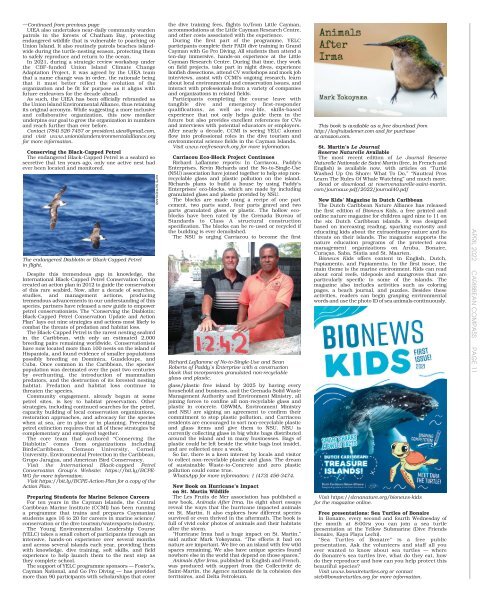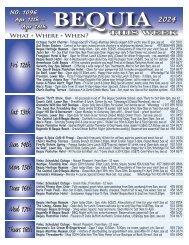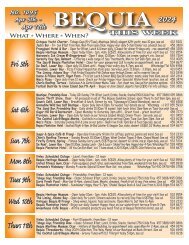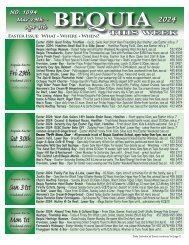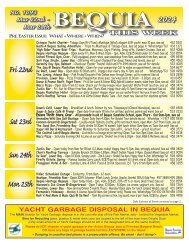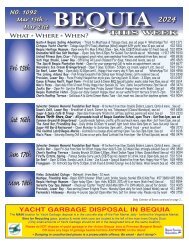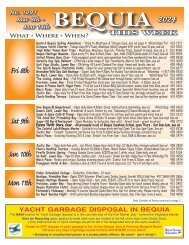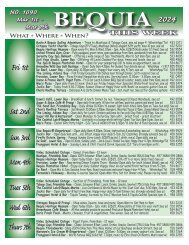Caribbean Compass Yachting Magazine - April 2022
Welcome to Caribbean Compass, the most widely-read boating publication in the Caribbean! THE MOST NEWS YOU CAN USE - feature articles on cruising destinations, regattas, environment, events...
Welcome to Caribbean Compass, the most widely-read boating publication in the Caribbean! THE MOST NEWS YOU CAN USE - feature articles on cruising destinations, regattas, environment, events...
Create successful ePaper yourself
Turn your PDF publications into a flip-book with our unique Google optimized e-Paper software.
— Continued from previous page<br />
UIEA also undertakes near-daily community warden<br />
patrols in the forests of Chatham Bay, protecting<br />
endangered wildlife that is vulnerable to poaching on<br />
Union Island. It also routinely patrols beaches islandwide<br />
during the turtle-nesting season, protecting them<br />
to safely reproduce and return to the ocean.<br />
In 2021, during a strategic review workshop under<br />
the CBF-funded Union Island Climate Change<br />
Adaptation Project, it was agreed by the UIEA team<br />
that a name change was in order, the rationale being<br />
that it must better reflect the evolution of the<br />
organization and be fit for purpose as it aligns with<br />
future endeavors for the decade ahead.<br />
As such, the UIEA has been officially rebranded as<br />
the Union Island Environmental Alliance, thus retaining<br />
its original acronym. While suggesting a more inclusive<br />
and collaborative organization, this new moniker<br />
underpins our goal to grow the organization in numbers<br />
and reach further than ever before.<br />
Contact (784) 526-7457 or president.uiea@gmail.com,<br />
and visit www.unionislandenvironmentalalliance.org<br />
for more information.<br />
Conserving the Black-Capped Petrel<br />
The endangered Black-Capped Petrel is a seabird so<br />
secretive that ten years ago, only one active nest had<br />
ever been located and monitored.<br />
The endangered Diablotin or Black-Capped Petrel<br />
in flight.<br />
Despite this tremendous gap in knowledge, the<br />
International Black-Capped Petrel Conservation Group<br />
created an action plan in 2012 to guide the conservation<br />
of this rare seabird. Now, after a decade of searches,<br />
studies, and management actions, producing<br />
tremendous advancements in our understanding of this<br />
species, partners have released a new guide to empower<br />
petrel conservationists. The “Conserving the Diablotin:<br />
Black-Capped Petrel Conservation Update and Action<br />
Plan” lays out nine strategies and actions most likely to<br />
combat the threats of predation and habitat loss.<br />
The Black-Capped Petrel is the rarest nesting seabird<br />
in the <strong>Caribbean</strong>, with only an estimated 2,000<br />
breeding pairs remaining worldwide. Conservationists<br />
have now located more than 100 nests on the island of<br />
Hispaniola, and found evidence of smaller populations<br />
possibly breeding on Dominica, Guadeloupe, and<br />
Cuba. Once common in the <strong>Caribbean</strong>, the species’<br />
population was decimated over the past two centuries<br />
by overhunting, the introduction of mammalian<br />
predators, and the destruction of its forested nesting<br />
habitat. Predation and habitat loss continue to<br />
threaten the species.<br />
Community engagement, already begun at some<br />
petrel sites, is key to habitat preservation. Other<br />
strategies, including continued searches for the petrel,<br />
capacity building of local conservation organizations,<br />
restoration approaches, and advocacy for the species<br />
when at sea, are in place or in planning. Preventing<br />
petrel extinction requires that all of these strategies be<br />
complementary and employed together.<br />
The core team that authored “Conserving the<br />
Diablotin” comes from organizations including<br />
Birds<strong>Caribbean</strong>, Clemson University, Cornell<br />
University, Environmental Protection in the <strong>Caribbean</strong>,<br />
Grupo Jaragua, and American Bird Conservancy.<br />
Visit the International Black-capped Petrel<br />
Conservation Group’s Website: https://bit.ly/BCPE-<br />
WG for more information.<br />
Visit https://bit.ly/BCPE-Action-Plan for a copy of the<br />
Action Plan.<br />
Preparing Students for Marine Science Careers<br />
For ten years in the Cayman Islands, the Central<br />
<strong>Caribbean</strong> Marine Institute (CCMI) has been running<br />
a programme that trains and prepares Caymanian<br />
students ages 16 to 20 for careers in marine science/<br />
conservation or the dive tourism/watersports industry.<br />
The Young Environmentalist Leadership Course<br />
(YELC) takes a small cohort of participants through an<br />
intensive, hands-on experience over several months<br />
and across several islands each year, providing them<br />
with knowledge, dive training, soft skills, and field<br />
experience to help launch them to the next step as<br />
they complete school.<br />
The support of YELC programme sponsors — Foster’s,<br />
Cayman National, and Go Pro Diving — has provided<br />
more than 90 participants with scholarships that cover<br />
KATE SUTHERLAND<br />
the dive training fees, flights to/from Little Cayman,<br />
accommodations at the Little Cayman Research Centre,<br />
and other costs associated with the experience.<br />
During the first part of the programme, YELC<br />
participants complete their PADI dive training in Grand<br />
Cayman with Go Pro Diving. All students then attend a<br />
ten-day immersive, hands-on experience at the Little<br />
Cayman Research Centre. During that time, they work<br />
on field projects, take part in night dives, experience<br />
lionfish dissections, attend CV workshops and mock job<br />
interviews, assist with CCMI’s ongoing research, learn<br />
about local environmental and conservation issues, and<br />
interact with professionals from a variety of companies<br />
and organizations in related fields.<br />
Participants completing the course leave with<br />
tangible dive and emergency first-responder<br />
qualifications, as well as real-life, skills-based<br />
experience that not only helps guide them in the<br />
future but also provides excellent references for CVs<br />
and interviews with potential educators or employers.<br />
After nearly a decade, CCMI is seeing YELC alumni<br />
flow into professional roles in the dive tourism and<br />
environmental science fields in the Cayman Islands.<br />
Visit www.reefresearch.org for more information.<br />
Carriacou Eco-Block Project Continues<br />
Richard Laflamme reports: In Carriacou, Paddy’s<br />
Enterprises, Kevin Richards and the No-to-Single-Use<br />
(NSU) association have joined together to help stop nonrecyclable<br />
glass and plastic pollution on the island.<br />
Richards plans to build a house by using Paddy’s<br />
Enterprises’ eco-blocks, which are made by including<br />
granulated glass and plastic provided by NSU.<br />
The blocks are made using a recipe of one part<br />
cement, two parts sand, four parts gravel and two<br />
parts granulated glass or plastic. The hollow ecoblocks<br />
have been rated by the Grenada Bureau of<br />
Standards to Class A structural construction<br />
specification. The blocks can be re-used or recycled if<br />
the building is ever demolished.<br />
The NSU is urging Carriacou to become the first<br />
Richard Laflamme of No-to-Single-Use and Sean<br />
Roberts of Paddy’s Enterprise with a construction<br />
block that incorporates granulated non-recyclable<br />
glass and plastic.<br />
glass/plastic free island by 2025 by having every<br />
household and business, and the Grenada Solid Waste<br />
Management Authority and Environment Ministry, all<br />
joining forces to confine all non-recyclable glass and<br />
plastic in concrete. GSWMA, Environment Ministry<br />
and NSU are signing an agreement to confirm their<br />
commitment to stop plastic pollution, and Carriacou<br />
residents are encouraged to sort non-recyclable plastic<br />
and glass items and give them to NSU. NSU is<br />
currently collecting glass in big white bags distributed<br />
around the island and in many businesses. Bags of<br />
plastic could be left beside the white bags (not inside),<br />
and are collected once a week.<br />
So far, there is a keen interest by locals and visitor<br />
to collect non-recyclable plastic and glass. The dream<br />
of sustainable Waste-to-Concrete and zero plastic<br />
pollution could come true.<br />
WhatsApp for more information: 1 (473) 456-3474.<br />
New Book on Hurricane’s Impact<br />
on St. Martin Wildlife<br />
The Les Fruits de Mer association has published a<br />
new book, Animals After Irma. Its eight short essays<br />
reveal the ways that the hurricane impacted animals<br />
on St. Martin. It also explores how different species<br />
survived or even thrived in the aftermath. The book is<br />
full of vivid color photos of animals and their habitats<br />
after the storm.<br />
“Hurricane Irma had a huge impact on St. Martin,”<br />
said author Mark Yokoyama. “The effects it had on<br />
nature are important. We live on an island with few wild<br />
spaces remaining. We also have unique species found<br />
nowhere else in the world that depend on those spaces.”<br />
Animals After Irma, published in English and French,<br />
was produced with support from the Collectivité de<br />
Saint-Martin, the Agence nationale de la cohésion des<br />
territoires, and Delta Petroleum.<br />
This book is available as a free download from<br />
http://lesfruitsdemer.com and for purchase<br />
at amazon.com.<br />
St. Martin’s Le Journal<br />
Reserve Naturelle Available<br />
The most recent edition of Le Journal Reserve<br />
Naturelle Nationale de Saint-Martin (free, in French and<br />
English) is available now, with articles on “Turtle<br />
Washed Up On Shore: What To Do,” “Nautical Pros<br />
Learn The Rules Of Whale Watching” and much more.<br />
Read or download at reservenaturelle-saint-martin.<br />
com/journaux-pdf/<strong>2022</strong>/journal40.pdf<br />
New Kids’ <strong>Magazine</strong> in Dutch <strong>Caribbean</strong><br />
The Dutch <strong>Caribbean</strong> Nature Alliance has released<br />
the first edition of Bionews Kids, a free printed and<br />
online nature magazine for children aged nine to 11 on<br />
the six Dutch <strong>Caribbean</strong> islands. It was designed<br />
based on increasing reading, sparking curiosity and<br />
educating kids about the extraordinary nature and its<br />
threats on their islands. The magazine supports the<br />
nature education programs of the protected area<br />
management organizations on Aruba, Bonaire,<br />
Curaçao, Saba, Statia and St. Maarten.<br />
Bionews Kids offers content in English, Dutch,<br />
Papiamento, and Papiamentu. In the first issue, the<br />
main theme is the marine environment. Kids can read<br />
about coral reefs, tidepools and mangroves that are<br />
particularly specific to some of the islands. The<br />
magazine also includes activities such as coloring<br />
pages, a beach journal, and puzzles. Besides these<br />
activities, readers can begin grasping environmental<br />
words and use the photo ID of sea animals continuously.<br />
Visit https://dcnanature.org/bionews-kids<br />
for the magazine online.<br />
Free presentations: Sea Turtles of Bonaire<br />
In Bonaire, every second and fourth Wednesday of<br />
the month at 8:00pm you can join a sea turtle<br />
presentation at the Yellow Submarine (Dive Friends<br />
Bonaire, Kaya Playa Lechi).<br />
“Sea Turtles of Bonaire” is a free public<br />
presentation. Ask the volunteers and staff all you<br />
ever wanted to know about sea turtles — where<br />
do Bonaire’s sea turtles live, what do they eat, how<br />
do they reproduce and how can you help protect this<br />
beautiful species?<br />
Visit www.bonaireturtles.org or contact<br />
stcb@bonaireturtles.org for more information.<br />
APRIL <strong>2022</strong> CARIBBEAN COMPASS PAGE 11


